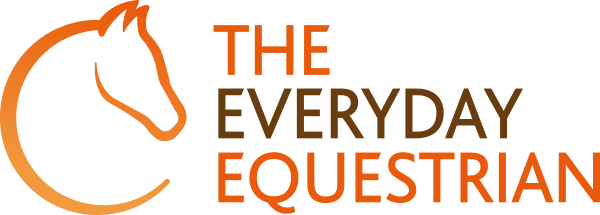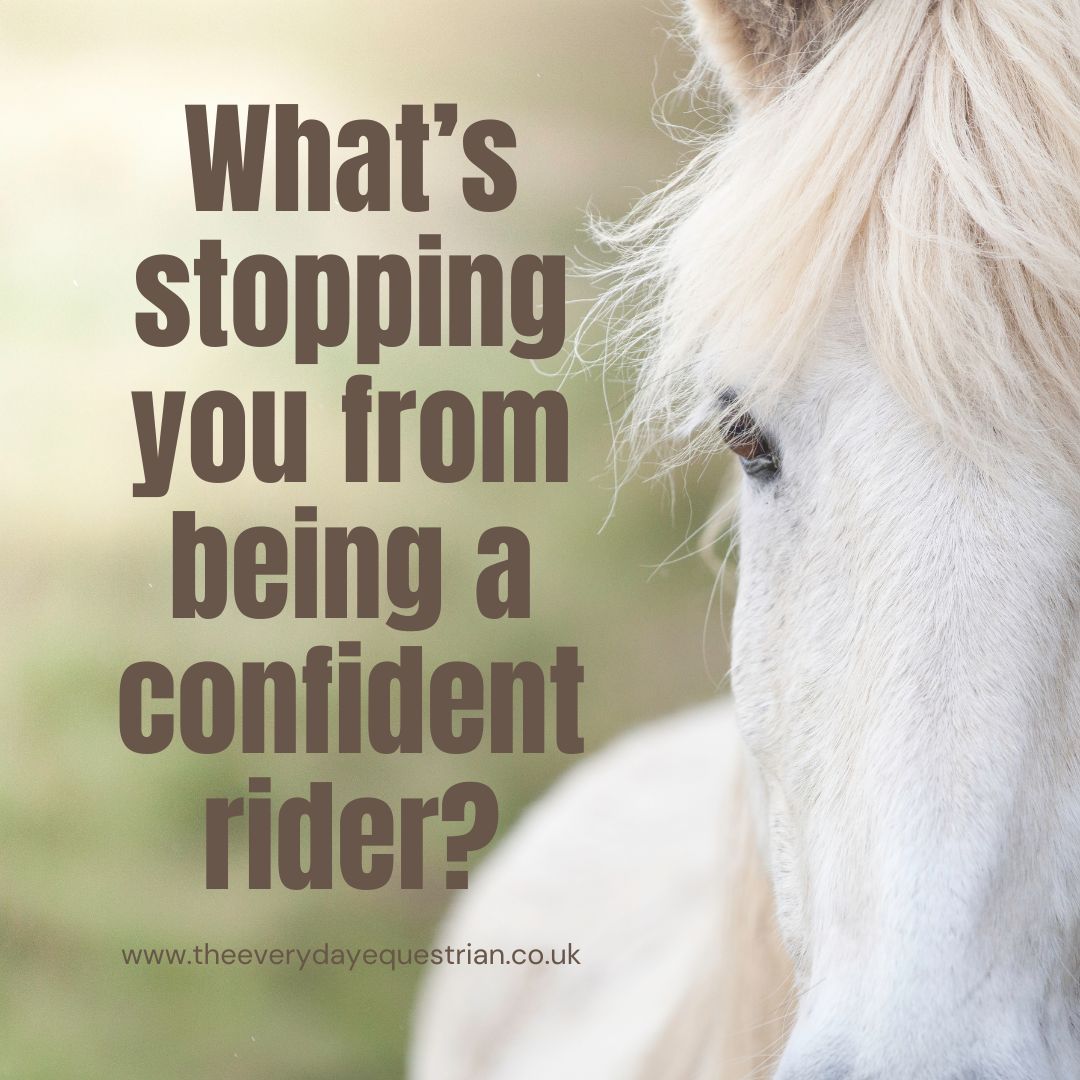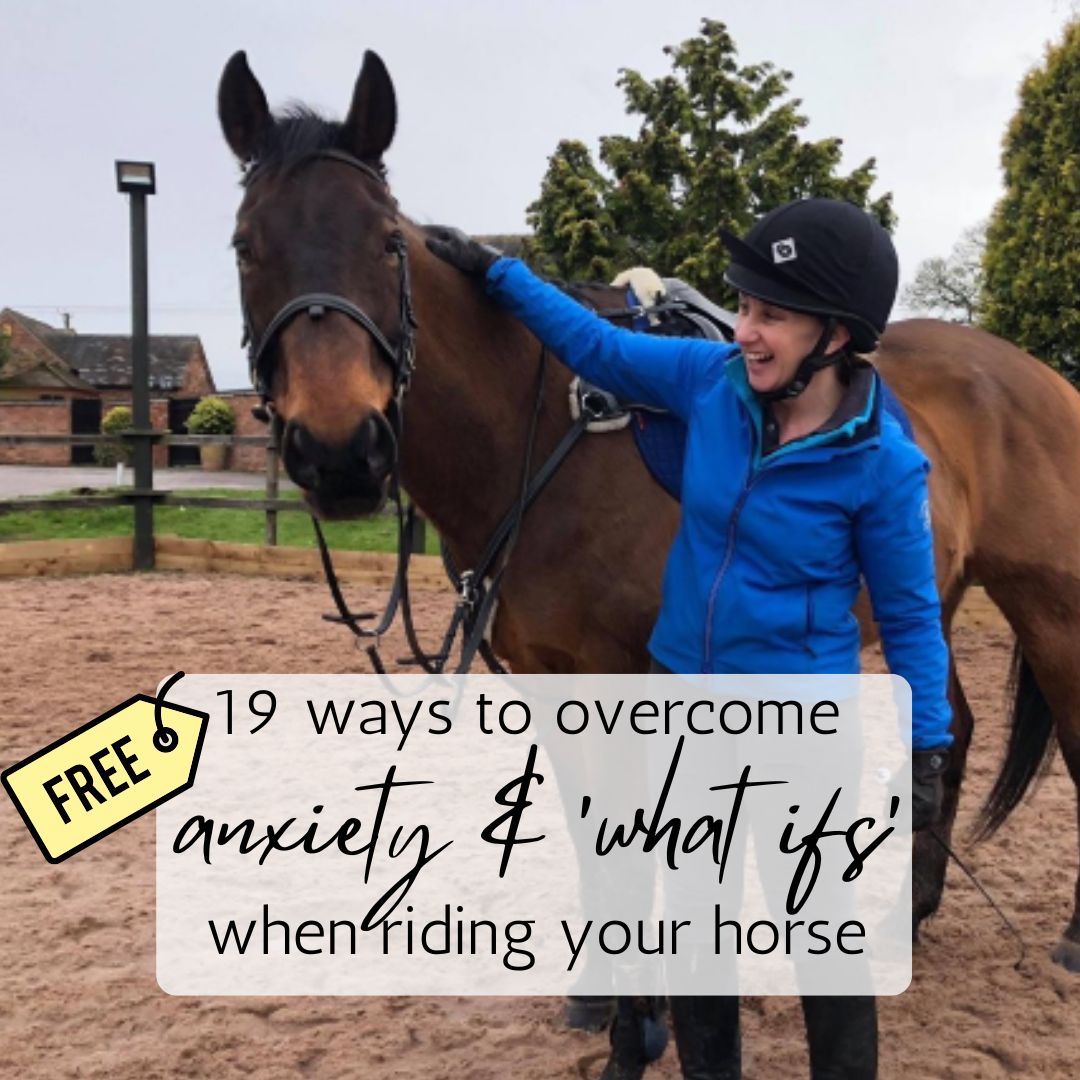Imagine you’re about to ride your horse, and your heart’s racing, your breathing is shallow, and your legs are like jelly. Despite knowing that you’ve done all this before, all the countless hours of schooling and lessons, a nagging voice in your head whispers, “What if…?” If this scenario feels all too familiar, you’re not alone. So many riders struggle with nerves and anxiety around riding, regardless of their experience level, grapple with confidence issues that stem not from a lack of skill or dedication, but instead from deep-rooted mindset blocks and limiting beliefs.
Confidence in riding isn’t just about how well you can ride; it’s also about how you manage your thoughts, emotions, and behaviours around riding. We’re all on our own path, and confidence is always fluid; sometimes we’re more confident, at other times we are feel stretched and challenged. From the fear of failure to the trap of comparisonitis and a tendency towards perfectionism, there are many mindset blocks, internal scripts and stories, and of course, self-limiting beliefs which get in our way.
But what if I told you that the biggest leap towards confidence doesn’t start in the saddle, but in your mind? In this article, we’ll explore the common mindset blocks and beliefs that might be holding you back from becoming the most confident rider you can be. We’ll dive into strategies to overcome these barriers, transforming them from obstacles into stepping stones on your path to confidence. Whether you’re a novice rider feeling overwhelmed by the journey ahead or an experienced equestrian struggling with hidden fears, this article is your first step towards a more confident and positive riding experience.
Here’s what we’ll cover in this article
Understanding Mindset in Riding
Let’s talk about what mindset really means for you as a rider. Think of your mindset as the lens through which you see your riding journey. It’s all about how you view your abilities and challenges. There are two main types of mindsets you might have: fixed and growth.
Fixed vs. Growth Mindset
Fixed Mindset: If you have a fixed mindset, you might believe that your skills and abilities are set in stone. You might think, “I’m just not a natural rider,” or “I’ll never be able to jump like that.” It’s as if you believe you’re born with a certain amount of talent, and that’s all you get. This mindset can make you feel stuck and less likely to try new things or push through challenges because you’re afraid of proving those limiting beliefs right.
Growth Mindset
On the other hand, with a growth mindset, you see your abilities as just the starting point. You believe that you can improve with practice, dedication, and the right guidance. It’s like looking at challenges and saying, “I might not be able to do this yet, but I’m going to learn how.” This mindset fuels your resilience, encourages you to embrace challenges, and helps you learn from feedback instead of fearing it.
Why It Matters
You might wonder, “Why is this important for me as a rider?” Well, your mindset can significantly affect how you approach your riding, how you deal with setbacks, and ultimately, how much you enjoy and succeed in the sport. A growth mindset can be your best ally, encouraging you to see every ride as an opportunity to learn and grow, even when things don’t go as planned.
Common Mindset Blocks
Navigating the world of riding is a bit like going on an adventure. It’s thrilling, but sometimes you might find yourself facing invisible barriers that make the journey seem harder than it should be. These barriers are often mindset blocks—those sneaky thoughts that creep in and whisper doubts into your ear. Let’s take a closer look at some of the most common ones and find out how you can leap over them.
Fear of Failure
First up is the fear of failure. It’s that uneasy feeling you get when you think about making a mistake or not living up to expectations—yours or others’. Remember, everyone makes mistakes, even the most seasoned riders. Instead of fearing mistakes, see them as chances to learn and grow. Next time you fall or miss a step, instead of telling yourself you’ve failed, ask, “What can I learn from this?” This shift in thinking can turn scary failures into helpful lessons.
Perfectionism
Then, there’s the trap of wanting to be perfect. Aiming for perfection in riding is like chasing the horizon; no matter how far you go, you’ll never quite reach it. And that’s okay. Riding is not about being flawless. It’s about the connection between you and your horse, improving bit by bit, and enjoying the journey. Give yourself permission to be a work in progress. Celebrate the small victories, like mastering a new skill or simply having a great day out with your horse.
Comparison with Others
Lastly, comparing yourself to others can be a huge roadblock. It’s easy to look at someone else’s achievements and feel like you’re not measuring up. But here’s the thing: every rider and horse is unique, with their own strengths, challenges, and pace of progress. Focus on your own journey. Set personal goals and celebrate your own achievements, no matter how big or small. Remember, the only person you should try to be better than is the person you were yesterday.
By recognising these mindset blocks for what they are—mere thoughts and not truths—you can start to overcome them. Embrace mistakes as learning opportunities, let go of the need to be perfect, and focus on your own path. This way, you’ll not only become a more confident rider, but you’ll also enjoy the ride a whole lot more.
Limiting Beliefs That Undermine Your Riding Confidence
Now that we’ve tackled those tricky mindset blocks, let’s shine a light on another set of hurdles on your path to becoming a confident rider: limiting beliefs. These are the stories you tell yourself about why you can’t do something, and they can really hold you back. But guess what? You have the power to change these stories and turn them into ones that lift you up instead of pulling you down. Let’s look at a few common limiting beliefs and how you can rewrite them.
“I’m not good enough”
This one’s a classic, and it can sneak up on you, making you doubt your abilities and worth as a rider. But here’s a secret: every rider has started where you are now, and nobody becomes a champion overnight. It takes time, practice, and a lot of patience. So, whenever you catch yourself thinking you’re not good enough, remind yourself of how far you’ve come and all the progress you’ve made. Celebrate every step forward, no matter how small. You are good enough, just by showing up and giving it your best.
“I’ll never be as good as [other riders]“
Comparing yourself to others is like looking through a distorted mirror—it only shows you a skewed version of reality. Remember, every rider’s journey is unique, including yours. Instead of comparing your chapter 1 to someone else’s chapter 20, focus on writing your own story. Set personal goals that matter to you and work towards achieving them at your own pace. Your journey is about becoming the best version of yourself, not a copy of someone else.
“My horse is too [insert negative trait] for me”
Sometimes, the challenge seems to lie not within you but with your horse. Maybe you think your horse is too spirited, too slow, or just not a good match for you. It’s easy to see these traits as limitations, but they can actually be opportunities for growth. Every horse has something to teach us, and every challenge is a chance to improve your skills as a rider and deepen your bond with your horse. Work on understanding your horse’s needs, communicate clearly, and remember that patience and consistent training can work wonders.
By challenging these limiting beliefs and reframing them into positive, empowering thoughts, you unlock a whole new level of confidence. It’s not about denying the difficulties but about facing them with a can-do attitude. Believe in yourself and your horse, embrace the journey with all its ups and downs, and watch as you both grow stronger and more confident together.
But you don’t have to do this path alone. If you’re looking for guidance, support, and a community of like-minded riders, our online rider confidence membership is just what you need. Inside, you’ll find resources, expert advice, and a supportive community all dedicated to helping you overcome your fears and build lasting confidence in the saddle. Whether you’re taking your first steps in riding or looking to take your mindset skills to the next level, our membership can help you achieve your goals.


